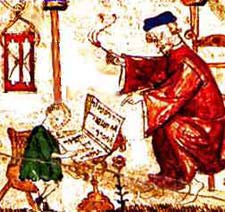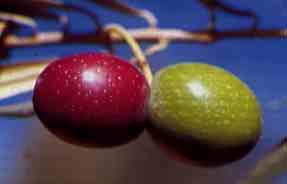- normal seed
- aborted seed
- no seed growth (parthocarpic)
Three different stages at a determined points in time.
Make me a Jewish Man is presented in the form of a parchment, in which images and text are shown horizontally (from left to right) rather than vertically. This hypertext is organized in 9 chapters which we can follow in a linear way. It is not an extensive hypertext; it contains more pictures and photographs than text.
As the hypertext progresses, we can observe that the writer uses a lot of images to explain us the story. There are images showing olive trees and everything related to olives, and images related to human beings in former times. They are mixed and, in some of them, there is a double image, that is to say, there is another image in which Popeye and Olivia appear in a comic extracts.
This hypertext makes a comparison between an olive tree and a man’s life; it compares the process of an olive tree since the root until the olives are mature enough, with the steps a Jewish man follows since he’s born until he became an Ideal Man. They must be prepared and guided from the earlier times, being looked after.
In the first chapter, “Listen”, we see two pictures which refer to ancient draws. It introduces us that we are going to deal with Ancient Israel.
In the second chapter, “The Law”, we can interpret “the root system of the olive tree is fundamental to its structure: anchorage, absorption and synthesis” as a temporary aspect because the roots are the principle of something, in this case, of the olive tree.
The Talmud within Ashkenasik culture, bring us back to Jewish history, as well as the Rabbi or the Roman which also refer to history.
In the third chapter, “Nurtured”, there is also a reference to traditional habits in the ancient times: “Rabbinic Judaism began to trace descent through the mother”.
In the fourth chapter, “The Cut”, the writer makes a comparison: “a tree of three years is equivalent to a male infant of eight days”, and then adds: “for three years the tree shall be uncircumcised for you...”.
“When Israelites circumsize their male children, they are pruning the fruit trees of God”. At the moment they are doing that to the children, another thing is occuring at the same time.
In the fifth chapter, “Planting”, it is explained the procedure an olive tree is suffering. Another aspect brings us back to the ancient times: “the mikveh, the ritual bath, is a natural body of water for purifying women after menstruation and birthing”. This is compared to the olives: “washing olives to remove foreign material that could contaminate the olive oil”.
“Before Hebrew- Israelite history...” is another temporary aspect we encounter in the hypertext.
In the sixth chapter, “Sissy”, a cross section structure of olive fruit history is shown:

|
Three different stages at a determined points in time. |
In the seventh chapter, “Disphallic”, we find another temporary aspect, this time refering to 17th century.
In the eighth chapter, “Training”, we observe one picture in which a boy is reading, guided by his master; he is reading moral principles of Jewish ethics. It is clearly a picture of the past.

In an 1823 Passover Haggada, the “wicked” son is depicted as a military man; the “righteous” son, a scholar. These are some of the traditions they had in that time.

A late 14th century Italian merchant is selling oil from a barrel with a tap. “Oil, the residual for the ideal life, makes the Ideal Man”.
In the last chapter, “Maturity”, we can look at one boy in a picture.
At 13 years a boy takes on 613 Biblical Commandments.
Maturation, a symbol of the passage of time, is illustrated by color change from green to reddish to purple, as it ripens.

“The perpetual lamp is never to go out; teaching, a light never to extinguish”.
This hypertext is very simple: it contains a title page with an index of the chapters. When we select one chapter, in the right column we can see three links: come back to the title page, go to all the images the text present or, go to the credits and bibliographical references. In the column of the left we have the list of the nine chapters.
Academic year 2008/2009
© a.r.e.a./Dr.Vicente Forés López
© Laura Tortosa Nieto
lautor2@alumni.uv.es
Universitat de València Press